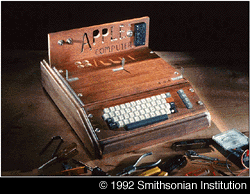What the other Steve has to say...
Date: n/a
Author: Autumn Spaulding 
Published at: www.landsnail.com
· · · Woz Biography · From the Garage to the Gigabyte · · ·
We owe a lot to Apple Computer. The machine with which you are viewing this page would never be without the two guys who built the first Apple in their garage. Stephen Wozniak, Steve Jobs, and their Apple Computer Company revolutionized the computing industry, bringing personal computers into the homes of tens, then hundreds, thousands and hundreds of thousands of homes across the world. Stephen Wozniak was the engineer behind it all. Here is the story of this revolutionary.
Stephen Wozniak
From the Garage to the Gigabyte
|
Stephen Wozniak was born in 1950, and grew up in Sunnyvale, California. As a kid, he loved electronics. "When we were in elementary school and Junior high school and even high school, it was neat to have other kids in electronics down the block. We would run house-to-house wired intercoms and somebody would build a neat little sound maker, and we'd go down to Sunnyvale electronics and buy the parts." Woz Wozniak, or "Woz," has been into electronics all of his life. By fifth grade he was building very large computer-like projects. For his sixth grade Science Fair Project he built a machine that played Tic-Tac-Toe. He got his HAM radio license in sixth grade as well. As he got older, he built more and more sophisticated computer projects. "It was all self-done; I didn't ever take a course, didn't ever buy a book on how to do it. Just pieced it together in my own head." Woz |
 |
Wozniak tried to top his own design every time, and eventually it paid off. If he had designed a computer with 200 chips, he'd try to design it with 150, then 100. When he got a job at Hewlett Packard designing calculators, he slowed down his computer work. Then he realized that a calculator was a kind of computer, too, except that it used little tiny parts called microprocessors. When he realized how cheap these were, he saw that he could finally afford to build a computer out of these, if he saved a lot. Out of this came the Apple 1. (Srivastava) |
In the industrial world, computers were being sold in kits. The pieces had to be soldered together and all the wires connected, usually resulting in many mistakes after quite a lot of hard work. People, even hobbyists and engineers, would come to the stores and want a computer already built. Stores began to buy the kits, solder them together themselves, and sell them. Wozniak got his idea for the Apple 1 from a TV set and a typewriter. "That made me think a computer should be laid out like a typewriter with a video screen. I'd learned enough about circuitry in high school electronics to know how to drive a TV and get it to draw...." Woz Wozniak built his Apple 1 with the intention that it would be easy to use, useful for solving problems, and good for playing games.
Wozniak belonged to the Homebrew Computer Club, and brought his products there. He had no idea they would sell; it was like a hobby to him. They talked about it being a computer revolution, but they didn't expect it  to change the world. The big companies, like IBM and Hewlett Packard, sneered at the little products they had built with microprocessors. to change the world. The big companies, like IBM and Hewlett Packard, sneered at the little products they had built with microprocessors.
But at the Homebrew Computer Club, Wozniak was a hit. People treated him as if he were the leader of a new technology--which he was. He helped people build their own computers and passed out schematics. Steve Jobs hooked up with him, suggesting they build a PC board, and together they went into business. They started out with fifty boards, hoping to sell them all. It was a big investment for them, but they were young and having fun. Steve Jobs had said, "Even if we lose our money, at least we had a company." Woz
 They named their fledgling company Apple. "You didn't have to have a real specific reason for choosing a name when you were a tiny little company of two people; you choose any name you want." Woz They named their fledgling company Apple. "You didn't have to have a real specific reason for choosing a name when you were a tiny little company of two people; you choose any name you want." Woz
Soon, Apple was heard all over the world.
Three people were responsible for Apple's early success: Steve Jobs, Mike Markkula, and Stephen Wozniak. Jobs had the idea of selling presassembled, ready-to-use computers. Mike Markkula provided capital, credibility, and business sense, though he never actually worked for the company. And Wozniak was the engineer who made it all fit together. (Kawasaki)
With such a revolutionary idea, it is a wonder that the big companies didn't pick it up until later. Some people conjecture that Jobs and Woz were just a couple of hippie kids trying to make a buck. Maybe that's true, but they succeeded even beyond their own wildest dreams. (Kawasaki)
Further reading: The university of Vermont has a wonderful and more complete biography of Stephen Wozniak. Find this under Sources in the article by Manish Srivastava. General information was collected from this and Kidwell's Landmarks. Pictures from various of the sites cited under sources.
Sources:
http://www.fogcity.com/macway/woz.htm
Steve Wozniak, Hacker and Humanitarian, copyright 1993, Guy Kawasaki.
From Hindsights--The Wisdom and Breakthroughs of Remarkable People.
http://www.thetech.org/revolutionaries/wozniak/
An Interview with Stephen Wozniak. Jill Wolfson and John Leyba.
http://www.woz.org/Pages/Staff/Steve/steve.html/ Steve Wozniak's Home Page Stephen Wozniak and Auri Rahimzadeh.
http://ei.cs.vt.edu/~history/WOZNIAK.HTM Stephen Wozniak.
Manish Srivastava.
Kidwell, Peggy A. and Paul E. Ceruzzi,
Landmarks in Digital Computing; a Smithsonian Pictorial History.
Washington; Smithsonian Institution Press, 1994.
|
![]()